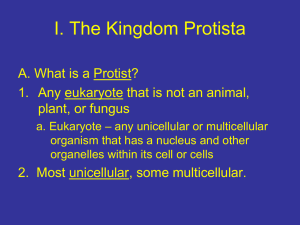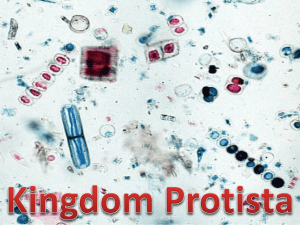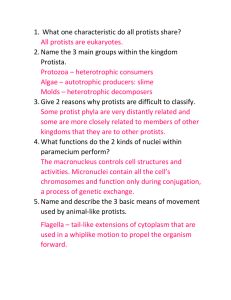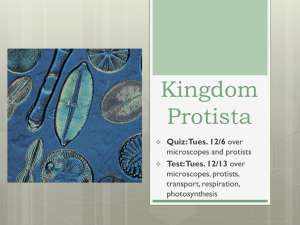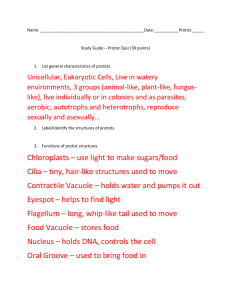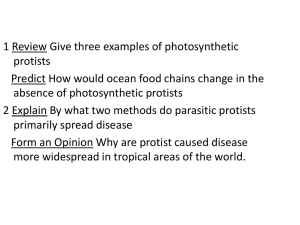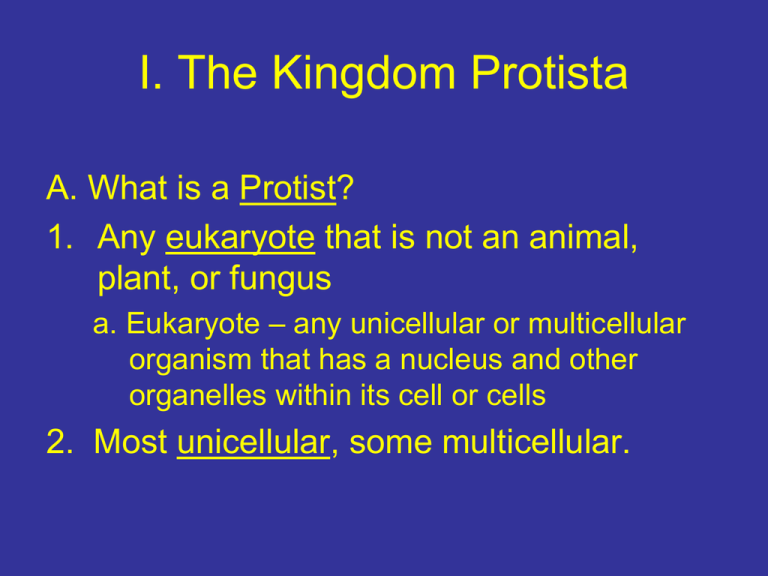
I. The Kingdom Protista
A. What is a Protist?
1. Any eukaryote that is not an animal,
plant, or fungus
a. Eukaryote – any unicellular or multicellular
organism that has a nucleus and other
organelles within its cell or cells
2. Most unicellular, some multicellular.
II. Protists were the first eukaryotic
organisms to evolve on Earth
A. Lynn Margulis- hypothesized first
eukaryotic cell formed by a close
relationship among several prokaryotes
B. Many scientists agree that animals and
plants evolved from protists.
www.sirinet.net
III. Classification of Protists
A. Classified by how they obtain food.
Include: Animal-like, Plant-like, and
Fungus-like protists
IV. Protozoans- animal-like protists
(Consumers) obtain food from
environment (they eat).
• Ex: Paramecium and Amoeba
Figure 20-5 A Ciliate
Section 20-2
Lysosomes
digestion
Trichosysts
- protection
Oral
groove mouth
Gullet - stomach
Anal Pore – waste
removal
Contractile
Vacuole – water
removal
Micronucleus –
Back up
Macronucleus –
memory
Daily functions
Go to
Section:
Food
Vacuoles
– Store
food
Cilia movement
An Amoeba
Section 20-2
Contractile vacuole
Pseudopods
Nucleus
Food vacuole
Go to
Section:
www.sirinet.net
B. Importance of Protozoa
(Animal-like protists)
1. Cause many human diseases like African
sleeping sickness and amoebic dysentery
(diarrhea)
Blood culture of Trypanosoma –
causes African
Sleeping Sickness
Fever, chills, neurological problems, coma, death
Image contributed by Pr. J. Le Bras, Hôpital Bichat
V. Slime molds and Water molds- funguslike protists are consumers that obtain
food by external digestion (this is weird).
Act like fungus, but cell structure is like
protists, no chitin in cell walls
A. Importance of Fungus-Like Protists
- Slime molds- important decomposers in
forests and swamps
- Water molds – decomposers in water,
parasites on land.
1. Water mold Phytophthora infestans
caused the Great Potato Famine in
Ireland in 1845.
http://www.sharnoffphotos.com/myxos1.html
VI. Algae- plant-like protists (producers)
use sunlight to make food through
the process of photosynthesis.
• Ex: Unicellular Algae and Multicellular
Algae
Euglena
Section 20-3
Chloroplast
Carbohydrate
storage bodies
Gullet
Pellicle protection
Flagellamovement
Go to
Section:
Nucleus
EyespotDetects light
Contractile
vacuole –water
removal
B. Importance of Algae (plant-like
protists)
1. Unicellular Algae – all contain some type of
chlorophyll, most contain accessory
pigments used for photosynthesis.
• Form the base of food chains in oceans as
phytoplankton
• Carry out the majority of earth’s
photosynthesis – produce most of Earth’s
oxygen
2. Algal blooms- huge masses of algae
quickly deplete nutrients in water; algal
cells quickly die in great numbers; their
decay depletes the supply of oxygen in
water; kills fish and invertebrates
A. Red tides- blooms of algae that
produce a potentially dangerous toxinshellfish can become full of the toxin- if
eaten can cause serious illness,
paralysis, even death
Algal Blooms
Red Tides
C. Importance of Multi-cellular Algae
1. Food source for many sea animals.
2. Home or refuge for many sea animals
(kelp forests and Sargasso sea).
3. Produce much of earth’s oxygen.
B. Human uses
1. Source of vitamin C and Iron.
B. Human uses
1. Source of vitamin C and Iron.
2. Wrap for sushi.
B. Human uses
1. Source of vitamin C and Iron.
2. Wrap for sushi.
3. Additive for ice cream, pudding, candy
bars.
4. Chemicals from Algae used in plastics,
waxes, deodorants, paints and lubricants.
5. Some chemicals extracted from algae
used to treat ulcers, high blood pressure,
etc.
Protists
Section 20-1
are classified as
animalike
called
protozoa
which
plantlike
Funguslike
called
called
algae
s
which
use
Produce food by
photosynthesis
Take in food from
environment
Go to
Section:
Slim molds
Water molds
External digestion
and include
Decomposers
parasites
: bioweb.uwlax.edu
White Cliffs of
Dover
www.calstatela.edu


